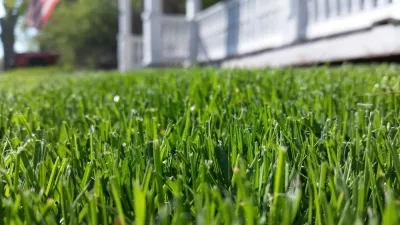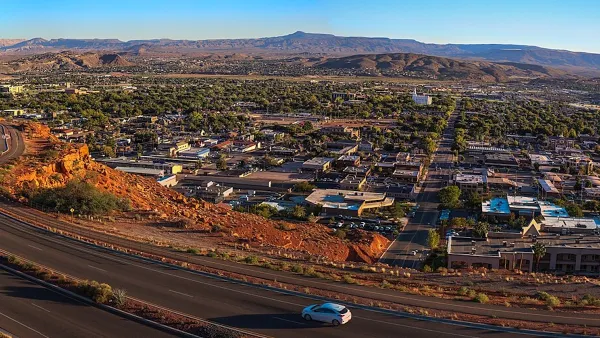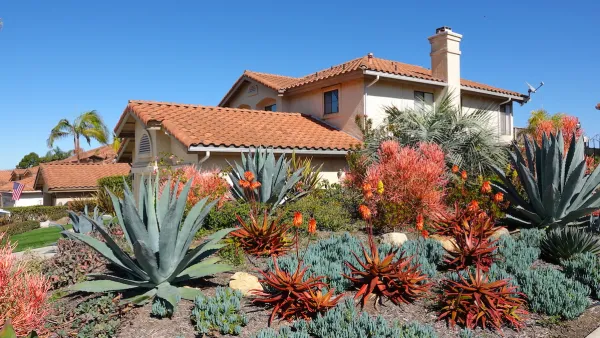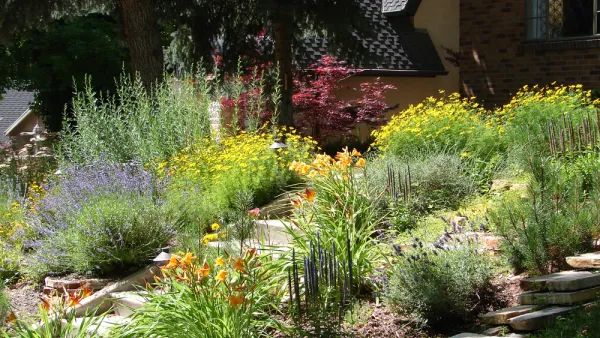Long held as a symbol of middle-class success and the American Dream, homogenous, monocultural lawns are quickly falling out of favor as people opt for more ecologically friendly gardens that conserve water and increase biodiversity.

Writing in the Washington Post, Dan Zak examines the American obsession with lawns and the growing anti-lawn movement gaining steam in an era of extreme water shortages.
American suburbia has long been defined by “Lawns: emerald green — no, alien green — and kept that way by maniacal vigilance and an elaborate system of pipes and potions, organic and otherwise, in defiance of ecology.” Zak positions awns as a container for our national anxieties, writing: “We’ve been sweeping our anxieties under these green comfort blankets for quite some time.”
In the early and middle parts of the twentieth century, “Lawns were a sign of taste, calm, power, privilege, order, discipline, especially in the aftermath of World War II.” More recently, that trend has reversed, as lawns “began to signal waste, disregard, disharmony, homogeneity, gentrification, zombie Boomerism.” While ornamental lawn grass is still the biggest crop in America, using 9 billion gallons of water a day, attitudes are shifting. “California’s main water utility is paying customers between $2 and $5 for each square foot of living turf that they remove. Last year Nevada outlawed certain types of lawn; rather, the state legislature prohibited the use of water from the dribbling Colorado River to feed certain types of “nonfunctional turf,” which in southern Nevada slurps up to 12 billion gallons of water every year (more than 10 percent of the state’s usage of the river).”
As landscaper Dave Marciniak points out, “Turf serves a purpose, he wrote. It’s soft and durable for recreation. It provides visual relief for the eye, and contrast for landscaping.” But other materials and plants can serve the same purpose, and more lawn devotees are realizing the potential of xeriscaping and other eco-friendly ways to replace lawns with sustainable, locally appropriate landscaping.
FULL STORY: There’s a water crisis. Why do we still have lawns?

Analysis: Cybertruck Fatality Rate Far Exceeds That of Ford Pinto
The Tesla Cybertruck was recalled seven times last year.

National Parks Layoffs Will Cause Communities to Lose Billions
Thousands of essential park workers were laid off this week, just before the busy spring break season.

Retro-silient?: America’s First “Eco-burb,” The Woodlands Turns 50
A master-planned community north of Houston offers lessons on green infrastructure and resilient design, but falls short of its founder’s lofty affordability and walkability goals.

Test News Post 1
This is a summary

Analysis: Cybertruck Fatality Rate Far Exceeds That of Ford Pinto
The Tesla Cybertruck was recalled seven times last year.

Test News Headline 46
Test for the image on the front page.
Urban Design for Planners 1: Software Tools
This six-course series explores essential urban design concepts using open source software and equips planners with the tools they need to participate fully in the urban design process.
Planning for Universal Design
Learn the tools for implementing Universal Design in planning regulations.
EMC Planning Group, Inc.
Planetizen
Planetizen
Mpact (formerly Rail~Volution)
Great Falls Development Authority, Inc.
HUDs Office of Policy Development and Research
NYU Wagner Graduate School of Public Service




























